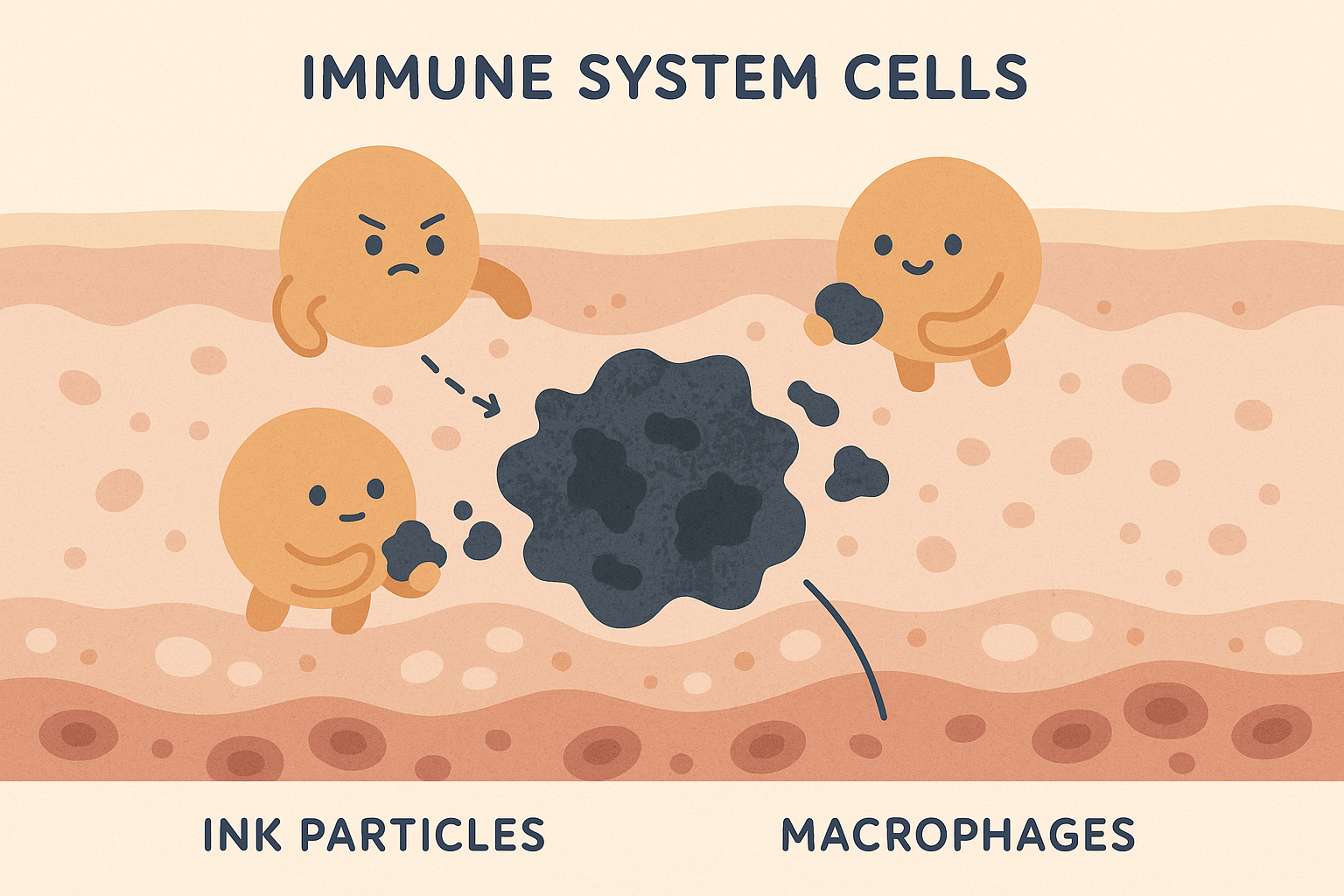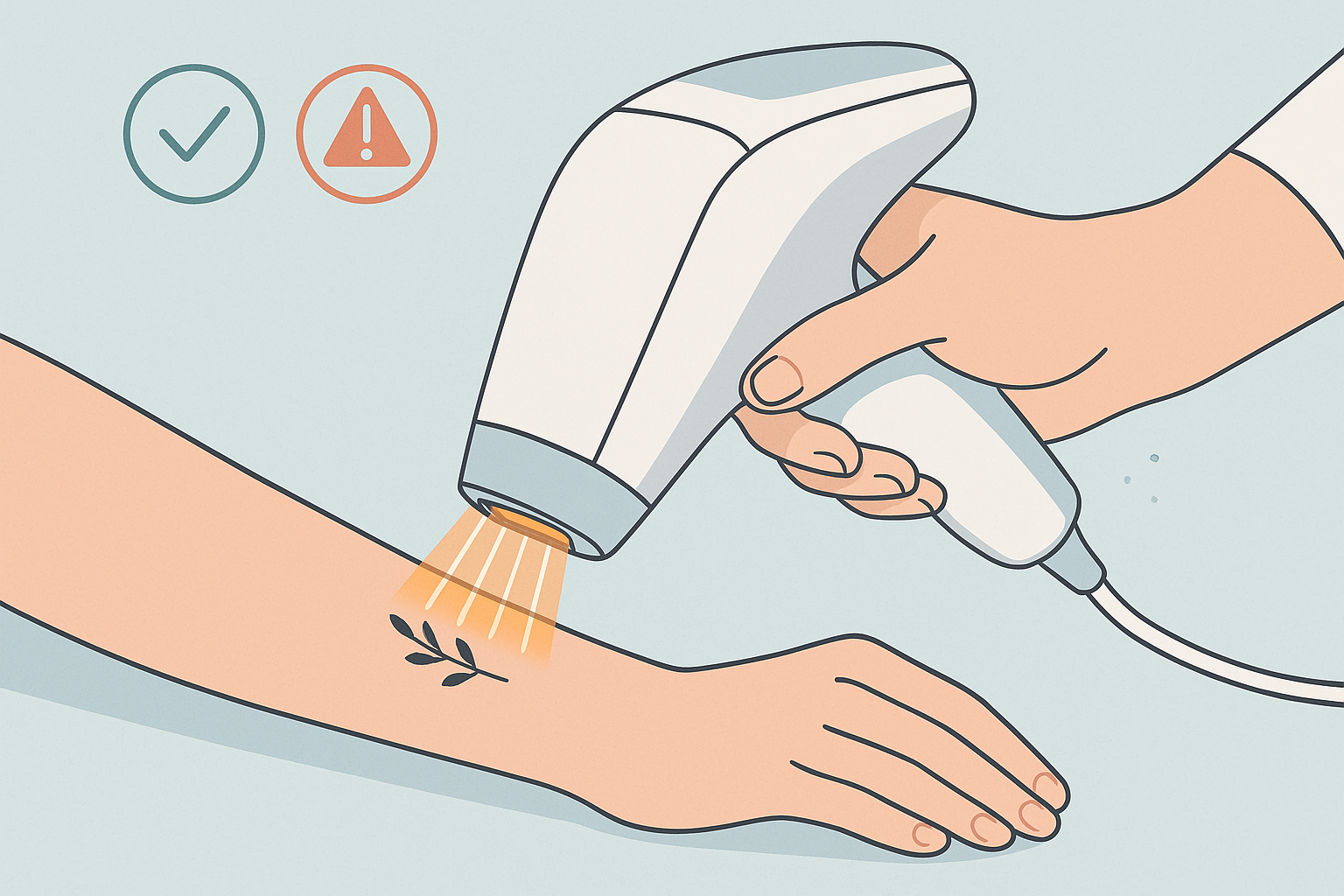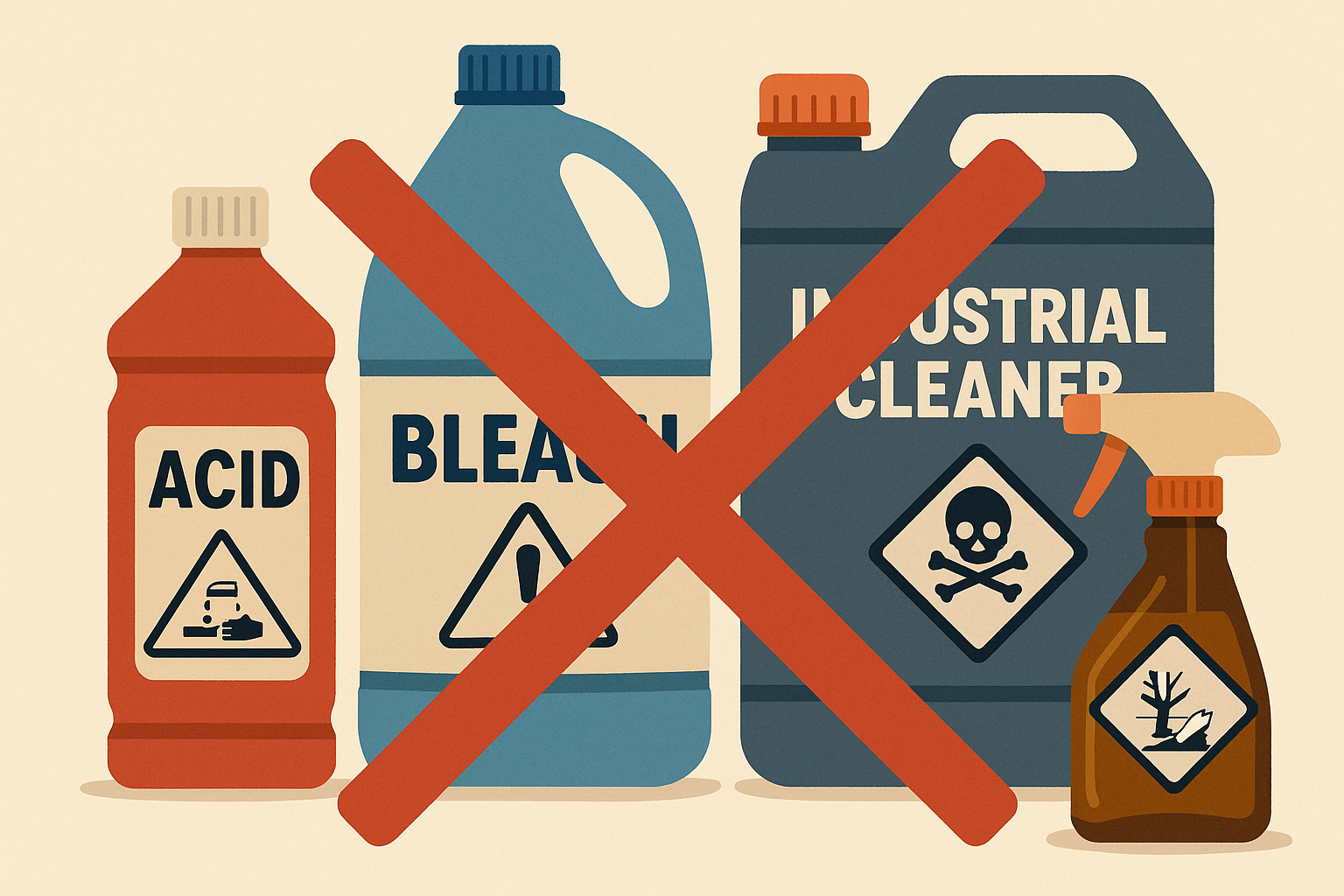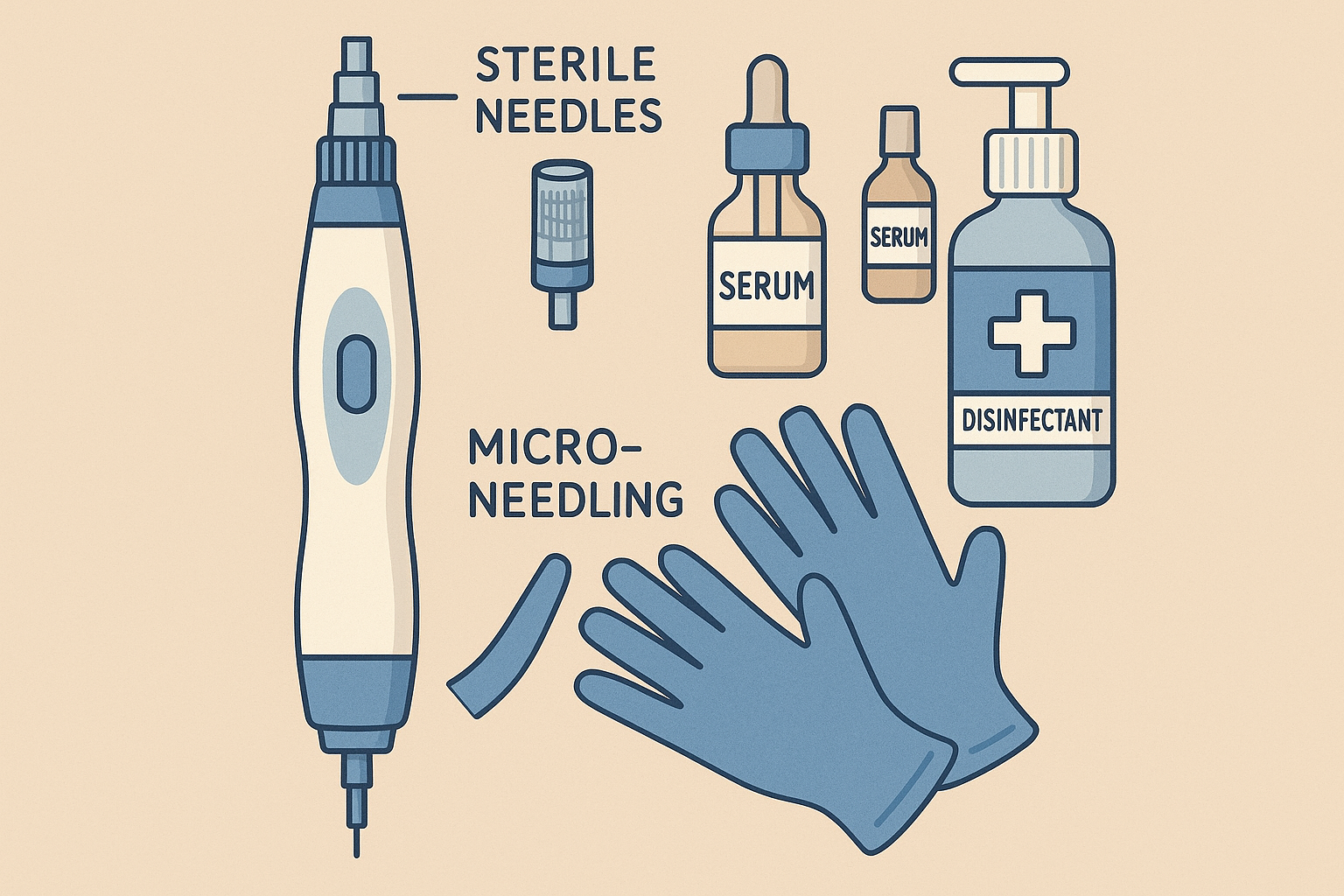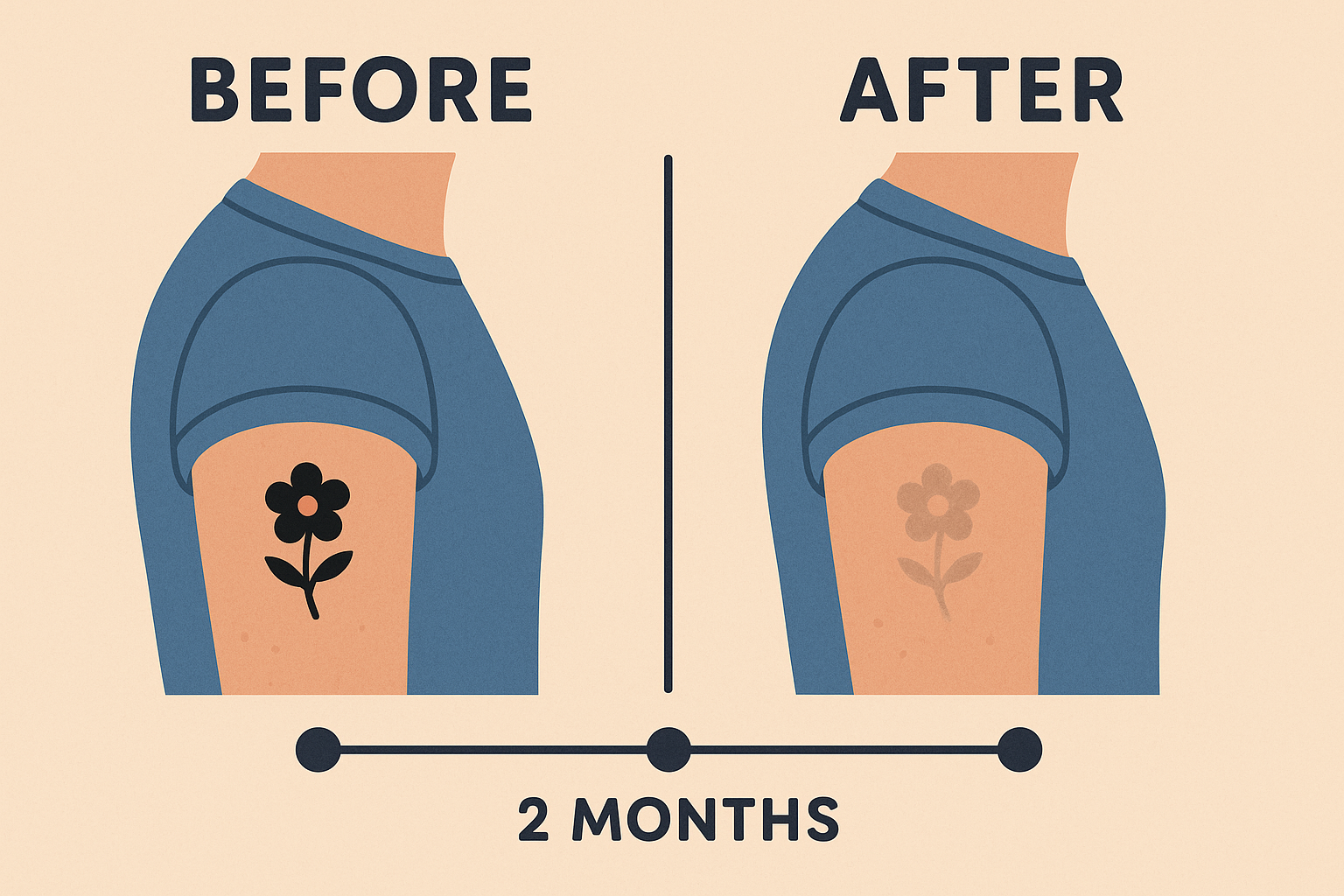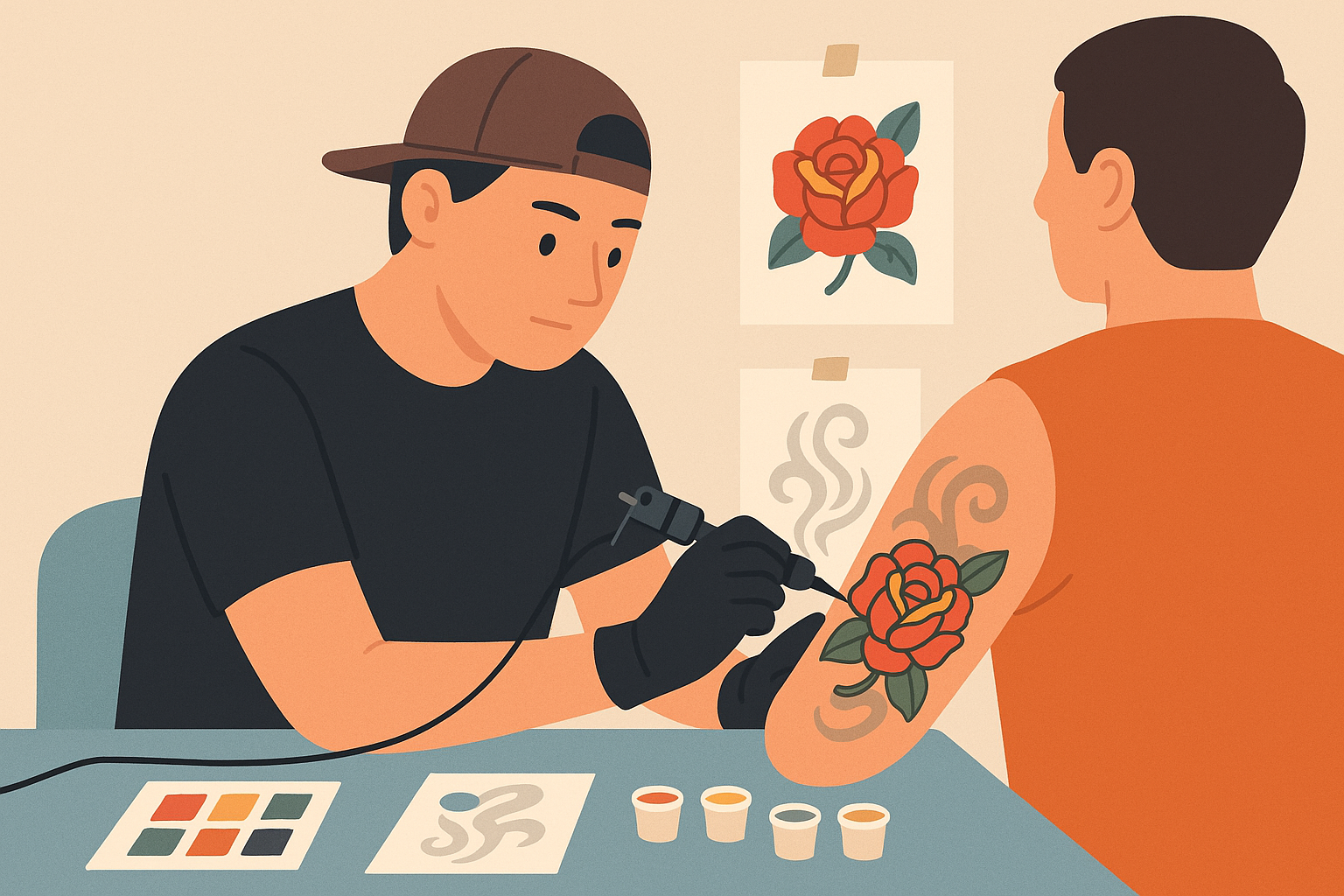At Home Tattoo Removal: The Real Psychology and Science Behind DIY Methods That Actually Work
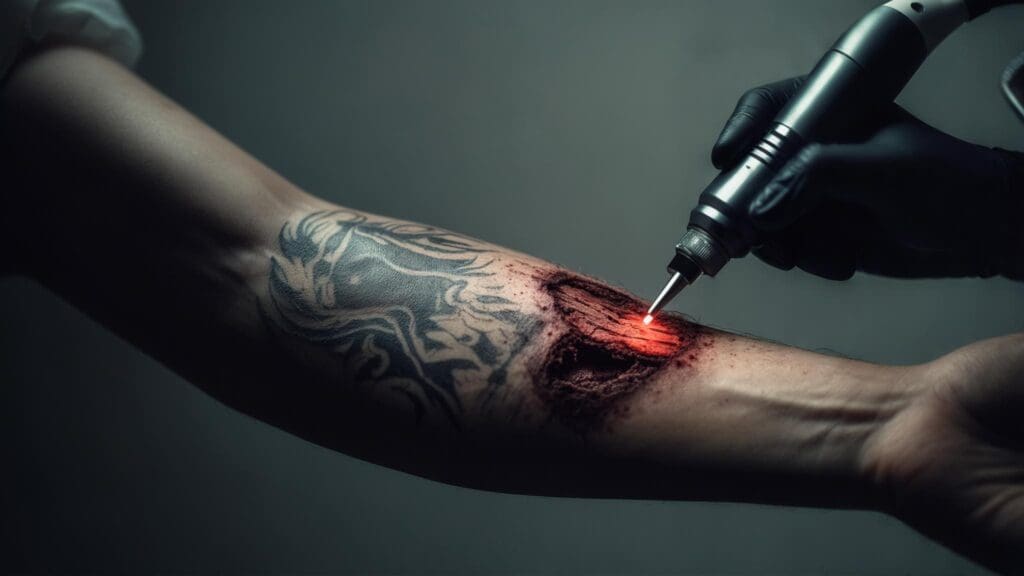
Look, we’ve all been there. You’re staring at that tattoo in the mirror, wondering what the hell you were thinking. Maybe it’s your ex’s name, maybe it’s that tribal design that seemed so cool in 2015, or maybe it just doesn’t fit who you are anymore.
The good news? You’re definitely not alone. The tattoo removal industry is absolutely booming – the global tattoo removal devices market is projected to reach USD 335.5 million by 2033, up from USD 155.4 million in 2023. But here’s the thing – when you’re desperate to get rid of ink, it’s easy to fall for dangerous “quick fixes” that’ll leave you worse off than when you started.
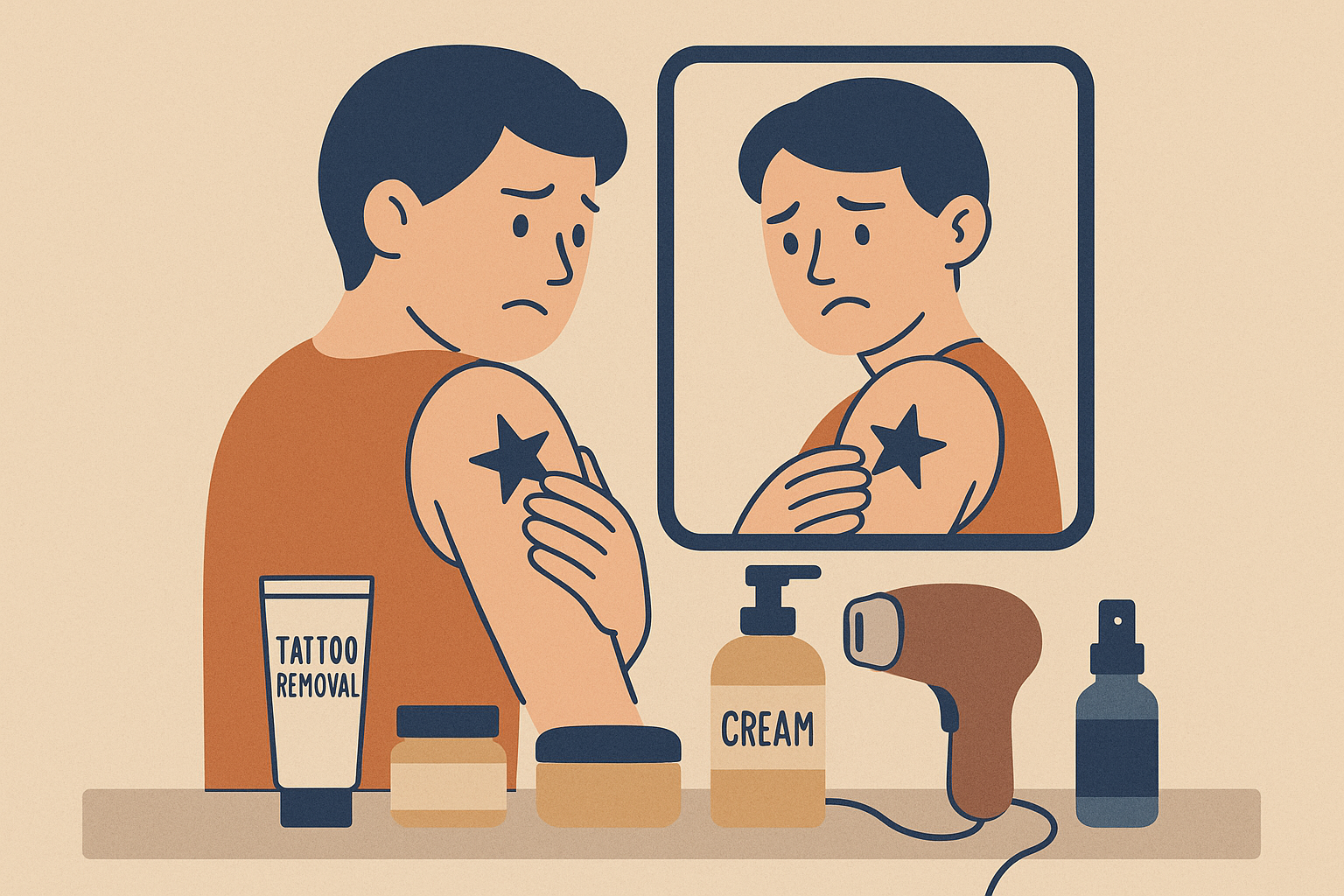
Table of Contents
- The Emotional Rollercoaster Behind Your Removal Decision
- Why Your Brain Tricks You Into Dangerous DIY Methods
- Natural Removal Science: What Your Body Actually Does
- Modern Home Tech That Won’t Destroy Your Skin
- Avoiding the DIY Horror Stories (And What Actually Works)
- Advanced Techniques for Serious DIY Removers
- Planning Your Professional Treatment Strategy
TL;DR
- Your headspace when you start removal matters more than you think – desperation leads to dangerous shortcuts
- Natural removal works with your body’s existing cleanup crew, not against it
- Home IPL devices can tackle black and dark blue ink, but forget about yellow, white, or neon colors
- Those “cheap” DIY methods usually cost more than professional treatment when you factor in the mess they create
- Microneedling plus topical treatments is your best bet for serious DIY attempts
- Acid burns will leave you with scars that make your original tattoo look like the Mona Lisa
- Smart partial removal can set you up for amazing cover-up work
The Emotional Rollercoaster Behind Your Removal Decision
Here’s something I’ve learned after talking to hundreds of people about tattoo removal – your headspace when you start this journey matters way more than you think. When you’re angry, embarrassed, or just desperate to make it disappear, you’re way more likely to try something stupid that’ll mess up your skin permanently.
Decoding Your Regret Type (And Why It Matters for Safety)
Not all tattoo regret is created equal, and honestly, the type of regret you’re dealing with pretty much determines whether you’ll make smart choices or end up with permanent scars.
Immediate regret hits like a freight train. You know the feeling – you wake up the next morning (or hell, maybe you don’t even make it that long) and you’re just horrified. Maybe it was your ex’s name that seemed brilliant six months ago, or that tribal design that doesn’t exactly scream “corporate professional.” This kind of regret is dangerous because it makes you desperate for quick fixes. When you can’t stand looking at something for another day, you’re way more likely to try harsh chemicals or crazy scrubs that’ll leave you looking like a burn victim.
Gradual dissatisfaction is different – it creeps up on you over months or years. Your style evolved, the tattoo aged like milk, or life just moved in a different direction. This slower burn actually works in your favor because you’re more likely to do your homework and choose methods that actually work instead of just whatever promises the fastest results.
Situational regret shows up around big life events. Job interview next month? New relationship? Family wedding where your conservative relatives will be there? The key here is figuring out if this regret is temporary or if you’re genuinely done with the tattoo forever.
The psychological side of tattoo regret often comes from making poor decisions in the first place. Understanding how tattoo meanings evolve over time can help you figure out if your regret is about changing symbolism or if you just genuinely hate the artwork.
Here’s a reality check: 26% of people with tattoos in the U.S. report regret over at least one of their tattoos. That regret often drives people to make impulsive decisions toward dangerous DIY methods instead of safer alternatives.
Take my friend Sarah – she learned this the hard way. She was head-over-heels in love and got her boyfriend’s name tattooed on her wrist during what she thought was the most romantic weekend ever. Three months later, after he cheated on her, she couldn’t stand looking at his name every day. In her anger and hurt, she ordered some sketchy acid peel online and ended up in the ER with a chemical burn that left her with scarring worse than any tattoo ever could.
The Money Psychology That’s Sabotaging Your Decisions
Let’s talk money, because I know that’s probably why you’re here reading about DIY methods. Professional laser removal is expensive as hell – we’re talking $200-$1,000 per session, and your tattoo will probably need 6-12 sessions. Yeah, that’s potentially $12,000 to fix a $200 mistake. I get why that makes you want to try literally anything else first.
But here’s where your brain starts playing tricks on you. Sunk cost fallacy messes with your head big time. You already dropped serious cash on that tattoo, so now you feel like you need to “save” that investment by trying cheap removal methods. This kind of thinking leads to skin damage that makes professional treatment way more expensive and less effective later.
Immediate gratification bias is another mental trap. Your brain wants that tattoo gone NOW, not in 12 months of professional sessions. So you gravitate toward DIY methods promising quick results, even when they’re less effective or downright dangerous.
There’s also this control thing going on. A lot of people choose at-home methods because they want control over the process, timeline, and pain level. I totally get this – the idea of being in charge of your own removal journey feels empowering. The good news is you can satisfy this need for control through safer methods that still give you agency.
Before you dive into removal, it’s worth understanding what you’re really getting into financially. Our guide on tattoo removal costs breaks down all the hidden expenses that make professional removal more cost-effective than most people realize.
Why Your Brain Tricks You Into Dangerous DIY Methods
Your brain is basically working against you when it comes to making smart removal decisions. Understanding these mental traps helps you recognize when your emotions might be pushing you toward dangerous methods.
The Hidden Economics of “Free” Natural Methods
Those “free” natural removal methods everyone talks about? They’re not actually free when you do the math, and I’ve run the numbers – they’re pretty eye-opening.
Time is money, and natural methods requiring daily treatment for 2-5 years represent a massive time investment. Even at minimum wage rates, the time you’ll spend on daily treatments often costs more than professional laser sessions – and that doesn’t even account for the psychological burden of having to think about your tattoo removal every single day for years.
Skin damage costs are the real kicker. When DIY attempts go wrong, you’re looking at dermatologist visits, chemical peels, or even reconstructive procedures that cost way more than the original professional removal would have. And guess what? Insurance won’t cover complications from self-treatment, so these expenses are entirely on you.
The DIY removal market is also kind of a scam. Products marketed specifically for tattoo removal cost 300-500% more than the same ingredients you can buy elsewhere, just because they slap “tattoo removal” on the label.
| DIY Method | Initial Cost | Time Investment | Hidden Costs | Total Real Cost |
|---|---|---|---|---|
| Natural creams | $50-200 | 2-5 years daily | Skin damage treatment $500-2000 | $550-2200 |
| Home IPL device | $200-800 | 6-12 months | Replacement parts $100-300 | $300-1100 |
| Chemical peels | $30-100 | 3-6 months | Burn treatment $1000-5000 | $1030-5100 |
| Professional laser | $1200-12000 | 6-18 months | Minimal complications | $1200-12000 |
Insurance Realities and Legal Blind Spots
Here’s something nobody talks about – when you treat yourself, you’re completely on your own. No professional liability protection, no medical malpractice coverage, nothing. If something goes wrong, you’re responsible for all the complications and costs.
Most DIY removal products come with disclaimers that basically say “if this messes up your skin, that’s your problem.” Understanding these limitations helps you figure out if the risk is really worth it.
The risks of unregulated removal services are getting worse too. “Specialist Wayne Joyce said he had seen an increase in people getting tattoo removals” and warns that some practitioners are “obtaining dangerous cheap lasers that don’t work properly” and using them in unsanitary conditions, leading to permanent scarring and serious psychological trauma.
Natural Removal Science: What Your Body Actually Does
Think of your immune system like a really persistent cleaning crew. Those little cells called macrophages are constantly trying to clean up what they see as “foreign junk” in your skin – including your tattoo ink. They’re already working on it 24/7, which is why really old tattoos start looking faded and blurry. Natural removal methods are basically just trying to help these guys do their job better.
How Your Immune System Actually Processes Tattoo Ink
Natural tattoo removal works with your body’s existing processes, not against them. Your immune system is already trying to get rid of that ink – you’re just giving it some backup.
Macrophage activity is your immune system’s natural response to tattoo ink. These specialized cells are like tiny garbage collectors that continuously try to remove foreign particles from your skin, including tattoo pigments. They never stop working, but they’re not exactly speed demons.
Your immune system’s ability to process tattoo ink depends on your overall health, age, and lifestyle. The healthier you are, the better your little cleanup crew works. Optimizing these factors can actually improve natural removal rates without any external intervention.
The key to natural removal is understanding that your body is already working to eliminate the ink – you’re just supporting and speeding up what’s already happening.
Circulation and Immune System Enhancement
Staying hydrated isn’t just good for your skin – it helps your immune cells do their job and helps your lymphatic system transport broken-down ink particles out of your body. This process takes months to years, but proper hydration makes it work better.
Nutrition matters too. Antioxidants and anti-inflammatory foods reduce stress around tattoo sites and support skin regeneration. Vitamin C, vitamin E, and omega-3 fatty acids help your body process ink particles more efficiently.
Better blood flow brings more immune cells to your tattoo while helping remove the processed ink particles through your lymphatic system. Massage therapy using specific techniques can improve circulation around tattoo sites and break up scar tissue that might be trapping ink particles.
Regular exercise isn’t just good for your heart – it supports your lymphatic system’s ability to process and remove cellular waste, including broken-down tattoo pigments. The better your circulation, the better your natural removal works.
Evidence-Based Topical Natural Treatments
Natural topical treatments work differently than harsh chemical peels or crazy scrubs. Understanding how they actually work helps you choose effective methods while avoiding dangerous alternatives.
Papaya enzyme treatments use papain, an enzyme that breaks down proteins. While tattoo ink isn’t protein-based, papain might help break down the protein matrix holding ink particles in place, potentially making them easier for your immune system to grab.
Pineapple enzyme applications use bromelain, another enzyme with anti-inflammatory properties. Regular application might help reduce inflammation around tattoo sites while supporting natural healing processes.
Some natural plant acids provide gentle exfoliation that might help with very superficial tattoo fading, though results are limited and you need to be consistent for months. Lemon juice contains citric acid for mild exfoliation, but it also makes your skin more sensitive to sun damage, so sunscreen becomes crucial.
Apple cider vinegar offers acetic acid for gentle exfoliation. You absolutely have to dilute it properly to prevent chemical burns, and honestly, results are pretty minimal for anything but the most superficial tattoos.
Understanding proper wound care becomes crucial when using natural methods that might irritate your skin. Our guide on tattoo aftercare has essential information about keeping your skin healthy during any removal process.
Here’s some perspective: the average length of tattoo removal is 8-12 treatments based on data from over 1.6 million treatments. This actually makes natural methods requiring years of consistent application seem more reasonable than you might think.
Modern Home Tech That Won’t Destroy Your Skin
Recent advances in home laser technology have made light-based treatments way more accessible through IPL devices and LED therapy systems. They’re not as powerful as professional equipment, but they can be effective for specific tattoo colors when you use them consistently and safely.
IPL Home Devices: Understanding What Actually Works
Home IPL devices use broad-spectrum light instead of focused laser beams to target tattoo pigments. They’re less powerful than professional lasers, but they have advantages for specific tattoo types and skin conditions.
Color matters – a lot. Black and dark blue inks absorb light most effectively, while yellow, white, and fluorescent colors basically laugh at home IPL devices. If your tattoo is mostly black or dark blue, you might have some luck. If it’s a rainbow masterpiece, don’t waste your money.
Treatment protocols for home IPL require patience and consistency. Most devices recommend treatments every 2-3 weeks, with visible results typically showing up after 3-6 months of consistent use for colors that actually respond.
Safety features include built-in skin tone sensors that prevent treatment on darker skin types where light absorption could cause burns. Understanding these limitations prevents injury while maximizing what the device can actually do.
Learning how to use IPL technology at home requires realistic expectations about which tattoo colors will respond and which won’t.
LED Light Therapy: The Supporting Player
LED light therapy uses specific wavelengths to promote healing and potentially support natural tattoo fading. While it’s not as direct as IPL, LED therapy might help your overall skin health during removal attempts.
Red light therapy (660-670nm) promotes cellular regeneration and might help heal skin damage from other removal methods. This supportive therapy can be combined with other natural approaches to improve overall skin health.
Near-infrared therapy (810-850nm) goes deeper into skin tissue and might help with circulation and lymphatic drainage around tattoo sites. While it’s not directly removing ink, this therapy supports your body’s natural processing mechanisms.
Safer Chemical Alternatives to Harsh Peels
Traditional chemical peels for tattoo removal often use dangerous acids that cause permanent scarring. Modern alternatives focus on gentler compounds that provide similar benefits with way less risk.
Glycolic acid from sugar cane provides alpha-hydroxy acid exfoliation that’s gentler than synthetic alternatives. Home-use concentrations (10-20%) offer mild exfoliation that might help with very superficial tattoos over long treatment periods.
Lactic acid from fermented milk products provides beta-hydroxy acid exfoliation with moisturizing properties. This gentler approach reduces the risk of over-exfoliation while still supporting natural skin turnover.
Enzyme-based peels use natural proteins to break down dead skin cells without harsh chemical action. Papain enzyme peels use papaya-derived enzymes to gently dissolve dead skin cells, while bromelain enzyme systems use pineapple enzymes for gentle exfoliation with anti-inflammatory benefits.
Take Mark, a 35-year-old teacher who used a home IPL device consistently for 8 months on his small black tribal tattoo. Following the manufacturer’s protocol of treatments every 3 weeks, he got about 60% fading, making the tattoo light enough for a successful cover-up. The total cost was $400 for the device plus time, compared to an estimated $2,000 for professional laser removal.
Avoiding the DIY Horror Stories (And What Actually Works)
I’m going to be straight with you here – the internet is full of dangerous tattoo removal methods that can cause permanent scarring, infection, or chemical burns. Understanding these risks helps you avoid methods that’ll leave you way worse off than your original tattoo.
Recognizing the Dangerous Methods That’ll Ruin Your Skin
Acid-based removers like hydrochloric acid, sulfuric acid, or industrial-strength peeling agents can cause third-degree burns that’ll land you in the emergency room. These chemicals destroy skin tissue without discrimination and often leave scarring that makes your original tattoo look like a masterpiece. If you’re thinking about using acid to burn off your tattoo, please don’t. I’ve seen the photos, and it’s nightmare fuel.
Bleaching agents such as high-concentration hydrogen peroxide or chlorine-based products cause chemical burns and permanent skin discoloration. These products don’t selectively target tattoo ink – they damage healthy skin tissue permanently.
Solvent-based removers including acetone, paint thinner, or other industrial solvents cause severe chemical burns and can poison you. These products are designed for industrial use and should never, ever be applied to human skin.
When people desperately search for quick removal methods, they often encounter these dangerous approaches that promise fast results but deliver permanent damage. DIY tattoo removal should never involve industrial chemicals or unregulated substances.
Infection Prevention That Actually Matters
Look, if you’re going to do anything that breaks your skin – and I mean anything – you need to be obsessive about keeping everything clean. I’m talking hospital-level clean, not just “I wiped it with a paper towel” clean. One infection can land you in the hospital and cost you way more than professional removal ever would.
Equipment sterilization means hospital-grade disinfection for any tools that touch broken skin. 70% isopropyl alcohol works for most home applications, but you need to be thorough about it.
Skin preparation involves washing thoroughly with antibacterial soap followed by alcohol disinfection before any removal procedure. This reduces bacteria and prevents nasty stuff from getting into treatment sites.
Post-treatment care includes proper wound cleaning, antibiotic ointment, and sterile bandages to prevent infection during healing. You need to know the signs of infection – increased redness, warmth, pus, or red streaking – so you can get help before things get really bad.
Wound Care That Prevents Complications
Proper wound care after DIY removal attempts prevents complications and helps you heal better, regardless of what removal method you used.
Cleaning procedures involve gentle washing with antibacterial soap and sterile water. Don’t scrub like you’re cleaning a dirty pan – that just introduces bacteria and delays healing.
Moisture management is about keeping wounds moist enough for optimal healing while preventing too much moisture that promotes bacterial growth. Medical-grade wound dressings provide the right moisture levels while protecting against contamination.
Healing monitoring means checking your wound daily for appearance, drainage, and surrounding skin condition. Understanding normal healing helps you identify problems early when intervention is most effective.
The psychological impact of failed removal attempts can be devastating. Understanding the psychology behind tattoo removal helps you maintain realistic expectations and avoid dangerous shortcuts that could make your situation worse.
Even celebrities with unlimited resources face lengthy, expensive removal processes. “Pete Davidson has already spent like $200K, and I’m like 30 percent done” on professional laser removal, showing how even money can’t buy instant results – which makes dangerous shortcuts even more tempting.
Advanced Techniques for Serious DIY Removers
Advanced DIY techniques like microneedling combined with topical treatments and controlled cold applications represent the most promising home removal methods, but they require serious skill, safety precautions, and proper equipment to do effectively without causing permanent damage.
Microneedling: The Most Promising Advanced Method
Microneedling combined with topical treatments is honestly one of the most promising advanced DIY approaches, though it requires significant skill and safety precautions to do it right.
Professional-grade microneedling devices designed for home use can help topical treatments penetrate deeper while promoting natural skin regeneration. For people asking how to remove a tattoo at home using advanced methods, microneedling offers the most scientifically-backed approach.
Needle depth for tattoo removal typically ranges from 1.5-2.5mm, which is deeper than standard cosmetic microneedling. This depth reaches the dermal layer where tattoo ink lives, but you need advanced technique to avoid scarring or nerve damage.
Sterile technique is more important than other DIY methods because you’re creating thousands of tiny wounds. You need hospital-grade sterilization protocols to prevent serious infections that could result in sepsis or permanent scarring.
Treatment frequency balances tissue healing time with removal progress. Most protocols recommend 4-6 week intervals between sessions to allow complete healing while maintaining momentum toward ink breakdown.
Understanding how to use microneedling for tattoo removal requires patience and proper technique to avoid complications that could make professional treatment more difficult later.
Topical Enhancement Through Microneedling
Microneedling creates temporary channels that allow deeper penetration of topical treatments, potentially making them more effective for tattoo removal.
Serum formulation combines multiple active ingredients that work together when delivered through microneedling channels. Vitamin C, retinoids, and peptides might enhance natural removal processes when delivered to the right skin depths.
Timing is everything – you need to apply topical treatments immediately after microneedling while the channels are still open. This narrow window (typically 30-60 minutes) maximizes absorption while minimizing contamination risk.
| Microneedling Protocol | Needle Depth | Treatment Frequency | Recovery Time | Risk Level |
|---|---|---|---|---|
| Basic cosmetic | 0.5-1.0mm | Weekly | 24-48 hours | Low |
| Intermediate removal | 1.5-2.0mm | Monthly | 1-2 weeks | Medium |
| Advanced removal | 2.0-2.5mm | 6-8 weeks | 2-4 weeks | High |
| Professional grade | 2.5-3.0mm | 8-12 weeks | 4-6 weeks | Very High |
Controlled Cryotherapy Applications
Controlled freezing techniques adapted from medical cryotherapy might help break down tattoo ink particles while promoting natural healing responses. However, these methods require extreme caution to prevent frostbite or permanent tissue damage.
Temperature control uses controlled cold application to damage ink-containing cells while preserving surrounding healthy tissue. You need precise temperature control to prevent tissue death while maximizing treatment effectiveness.
Dry ice applications require specialized handling equipment and safety protocols to prevent severe frostbite. Treatment temperatures of -10°C to -20°C might help break down ink particles without causing permanent tissue damage when applied correctly.
Safety monitoring requires real-time monitoring of tissue temperature and response to prevent permanent damage. You need to understand warning signs to prevent complications that could result in scarring worse than the original tattoo.
Jennifer, a 42-year-old nurse, combined microneedling with vitamin C serum treatments on her 15-year-old butterfly tattoo. Using a 1.5mm needle depth monthly for 8 months, she achieved 40% fading while keeping her skin healthy. Her medical background helped her maintain strict sterile technique, preventing infection complications that often mess up DIY attempts.
Planning Your Professional Treatment Strategy
A lot of people use DIY methods as prep for professional laser treatment or cover-up work, which requires strategic coordination of timing, documentation, and treatment approaches. Understanding how to optimize your skin health before professional intervention and coordinate with tattoo artists for cover-up prep can significantly improve outcomes while reducing overall costs and treatment time.
Preparing Your Skin for Professional Laser Treatment
Many people use DIY methods as preparation for professional laser treatment, either to reduce overall treatment costs or begin the removal process while saving for professional intervention.
Skin conditioning focuses on improving overall skin health through hydration, nutrition, and gentle exfoliation. Healthy skin responds better to laser treatment and heals more effectively between sessions.
Partial fading strategies use safe natural methods to begin ink breakdown before professional treatment. This approach might reduce the total number of professional sessions you need while giving you psychological benefits from seeing visible progress.
Recovery period management ensures you have adequate healing time between DIY treatments and professional sessions. Most dermatologists require 4-6 weeks of healing after aggressive DIY methods before they’ll start laser treatment.
Documentation involves photographing and recording all DIY treatments to provide accurate treatment history to professional providers. This documentation helps optimize professional treatment protocols and avoid complications.
The question of whether you can completely remove a tattoo depends on multiple factors including ink type, skin condition, and treatment approach. At-home tattoo removal can serve as effective preparation for professional treatment when done safely and methodically.
Understanding the pain involved in removal helps set realistic expectations for both DIY and professional methods. Our comprehensive tattoo pain chart explains why certain areas respond differently to removal treatments.
Professional treatment data shows that the average total cost to remove a small tattoo is between $1500 – $2,000 and increases the larger the tattoo is, making strategic DIY preparation potentially valuable for reducing overall treatment sessions and costs.
Strategic Cover-Up Preparation
DIY removal methods can prepare tattoos for cover-up work by reducing ink density and improving skin texture, making cover-up designs more effective and visually appealing.
Area-specific treatment focuses removal efforts on parts of tattoos that would interfere with cover-up designs while preserving elements that could be incorporated into new artwork. This strategic approach maximizes cover-up success while minimizing removal time and effort.
Ink density reduction uses gentle, consistent treatments to reduce overall tattoo darkness without complete removal. This approach makes cover-up designs more vibrant and allows for greater design flexibility.
Learning how to partially remove a tattoo at home can be more effective than complete removal when planning cover-up work, as it gives artists better canvas conditions for new designs.
Artist Collaboration for Better Results
Working with tattoo artists during DIY removal ensures that your efforts support rather than complicate future cover-up work. Professional input helps optimize removal strategies for specific cover-up goals.
Design consultation involves sharing removal progress with potential cover-up artists to ensure your DIY efforts align with cover-up requirements. This collaboration prevents wasted effort on removal that doesn ‘t support cover-up goals.
Timeline coordination balances removal progress with artist availability and seasonal considerations. Planning removal timelines around artist schedules ensures optimal results when you’re ready for cover-up work.
When planning cover-up work, understanding design principles becomes crucial. Our guide to cover-up tattoo ideas shows how strategic partial removal can create better foundations for new artwork.
Whether you’re planning complete removal or preparing for a cover-up, understanding your design options can help guide your removal strategy. Tattoo Generator IQ’s advanced AI platform helps you visualize potential cover-up designs while your removal process progresses, ensuring your efforts align with your ultimate goals. Our style blending capabilities and placement guides help you understand what makes tattoos age well or poorly – knowledge that prevents future regret cycles and informs both removal and future tattoo decisions.
Final Thoughts
At-home tattoo removal requires understanding your emotional motivations, managing realistic expectations, and prioritizing safety over speed. The most successful DIY removers approach the process methodically, understand their limitations, and know when to transition to professional treatment.
Your regret type directly influences your success rate and safety. Immediate regret pushes you toward dangerous shortcuts, while gradual dissatisfaction leads to better research and safer methods. Understanding this psychological component helps you make rational decisions rather than emotional ones that could leave you with permanent scarring.
The science behind natural removal is real but slow. Your immune system’s cleanup crew is continuously working to remove tattoo ink, and you can support this process through proper hydration, nutrition, and circulation enhancement. However, expecting dramatic results in weeks rather than months or years sets you up for disappointment and potentially dangerous escalation to harsh methods.
Modern home technology like IPL devices offers legitimate options for specific tattoo colors, particularly black and dark blue inks. These devices require consistent use over extended periods but can produce meaningful results when used properly with appropriate safety precautions.
The hidden costs of “free” natural methods often exceed professional treatment when you factor in time investment, potential skin damage, and the psychological burden of years-long treatment routines. Understanding these true costs helps you make more informed financial decisions about your removal approach.
Advanced techniques like microneedling combined with topical treatments show the most promise for serious DIY removers, but they require significant skill, proper equipment, and strict safety protocols. These methods bridge the gap between basic natural approaches and professional treatment but aren’t suitable for everyone.
Most importantly, know when to stop. Chemical burns, persistent infections, or worsening skin texture are signs that DIY methods aren’t working for your situation. Professional intervention becomes necessary to prevent permanent damage that’s worse than your original tattoo.


